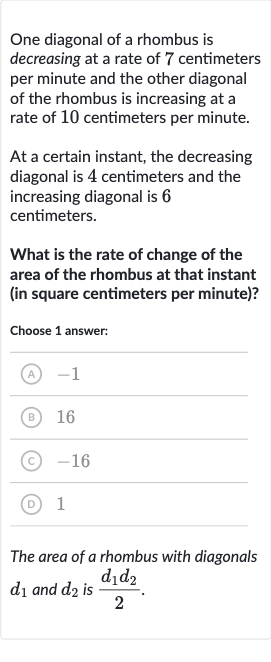AI tutor
Welcome to Bytelearn!
Let’s check out your problem:

One diagonal of a rhombus is decreasing at a rate of centimeters per minute and the other diagonal of the rhombus is increasing at a rate of centimeters per minute.At a certain instant, the decreasing diagonal is centimeters and the increasing diagonal is centimeters.What is the rate of change of the area of the rhombus at that instant (in square centimeters per minute)?Choose answer:(A) (B) (C) (D) The area of a rhombus with diagonals and is .
Full solution
Q. One diagonal of a rhombus is decreasing at a rate of centimeters per minute and the other diagonal of the rhombus is increasing at a rate of centimeters per minute.At a certain instant, the decreasing diagonal is centimeters and the increasing diagonal is centimeters.What is the rate of change of the area of the rhombus at that instant (in square centimeters per minute)?Choose answer:(A) (B) (C) (D) The area of a rhombus with diagonals and is .
- Rhombus Area Formula: The formula for the area of a rhombus is , where and are the lengths of the diagonals.
- Diagonal Lengths Given: Let's denote the decreasing diagonal as and the increasing diagonal as . At the instant we are considering, and .
- Rates of Change: The rate of change of is (since it's decreasing) and the rate of change of is (since it's increasing).
- Rate of Change Formula: To find the rate of change of the area, we'll use the product rule for differentiation, which in this context is .
- Calculation: Plugging in the values, we get .
- Final Result: Now, let's do the calculation:
More problems from Area of quadrilaterals and triangles: word problems
QuestionGet tutor help
QuestionGet tutor help
QuestionGet tutor help
QuestionGet tutor help
QuestionGet tutor help
QuestionGet tutor help
QuestionGet tutor help
